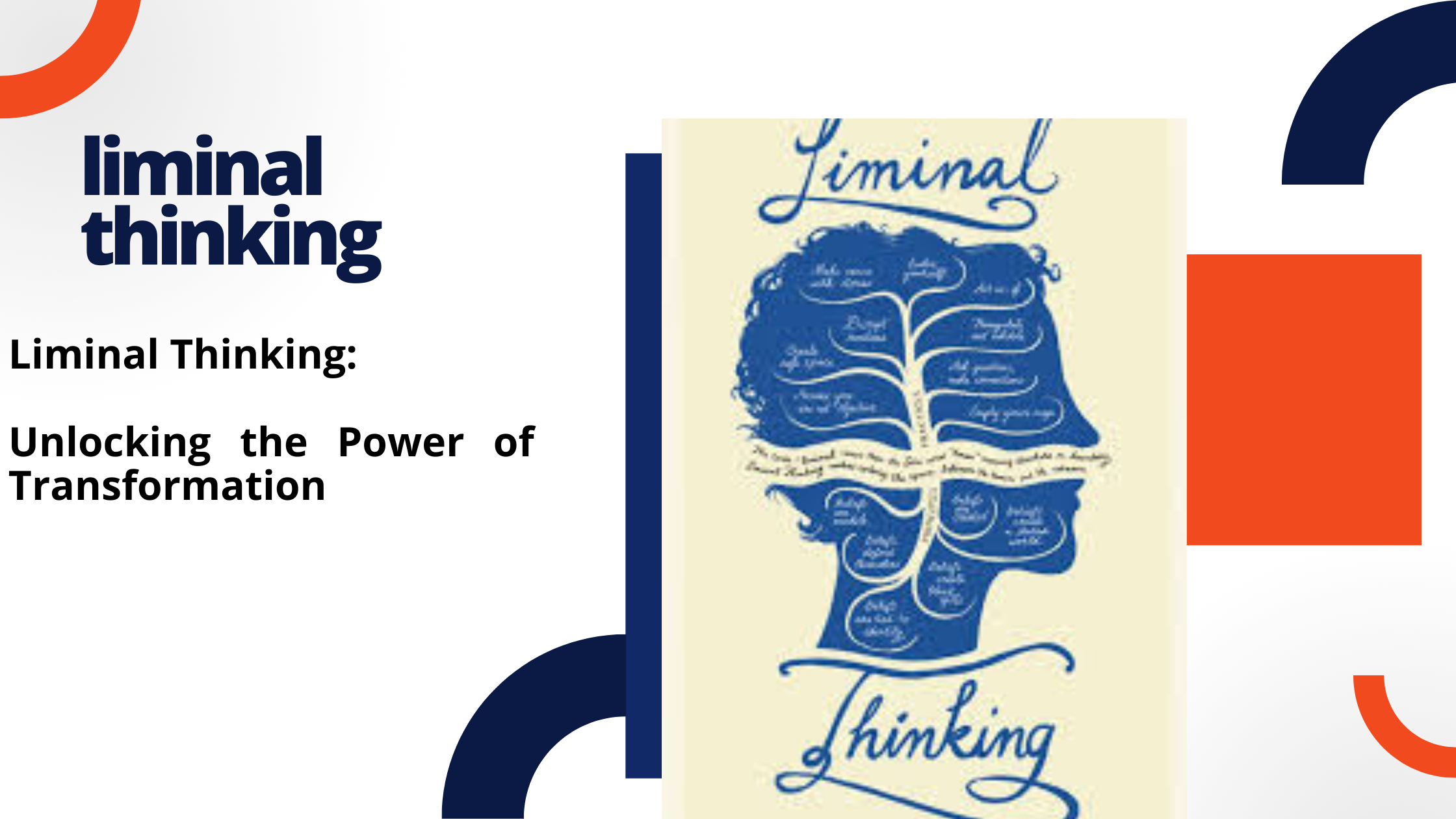
Liminal Thinking: Unlocking the Power of Transformation
In today’s fast-paced world, where change is the only constant, the ability of liminal thinking in new ways is more crucial than ever.
Whether you’re leading a team, driving innovation, or navigating personal growth, one approach that has gained traction for its transformative potential is liminal thinking.
This concept, which stems from the Latin word “limen,” meaning threshold, refers to the art of creating change by understanding and working within the spaces where ideas, beliefs, and perspectives intersect.
In this article, we will explore what thinking is, why it matters, and how you can harness its power to drive meaningful change in your life and work.
What is Liminal Thinking?
Liminal thinking is a mindset and a set of principles that help individuals and organizations embrace change by understanding and leveraging the thresholds of thought.
Unlike conventional thinking, which often operates within established boundaries and frameworks, thinking encourages us to step outside of these confines and explore the spaces where new ideas and possibilities emerge.
At its core, liminal thinking is about recognizing that our beliefs shape our reality.
It involves questioning these beliefs, understanding their origins, and being open to the possibility that they might not be as fixed or immutable as we once thought.
By embracing this fluidity of thought, liminal thinkers are able to navigate ambiguity, uncertainty, and change more effectively.
The Importance of Liminal Thinking
In an era defined by rapid technological advancements, globalization, and shifting social norms, the ability to adapt and evolve is critical.
However, change is often met with resistance, both on an individual and organizational level. This resistance typically stems from deeply held beliefs and assumptions that limit our ability to see new possibilities.
Liminal thinking helps to overcome these barriers by fostering a mindset of curiosity .But openness, and adaptability. It encourages us to question the status quo, challenge our assumptions, But explore new ways of thinking and being.
So you can better navigate the complexities of modern life and create the conditions necessary for innovation and growth.
Principles of Liminal Thinking
To practice liminal thinking, it is helpful to understand the key principles that underpin this approach. These principles serve as a guide for navigating the thresholds of thought and embracing the potential for change.
- Beliefs Are Models: Our beliefs are not objective truths; they are models we create to make sense of the world. These models are shaped by our experiences, culture, and context, and they can change as our understanding evolves.
- Beliefs Are Learned: We learn our beliefs through experiences, education, and social interactions. Recognizing that beliefs are learn allows us to question their validity and explore alternative perspectives.
- Beliefs Are Self-Reinforcing: Once we adopt a belief, we tend to seek out information that confirms it and dismiss information that contradicts it. This self-reinforcing cycle can create blind spots and limit our ability to see new possibilities.
- Beliefs Create a Shared Reality: Our beliefs shape not only our individual perceptions but also the collective reality we share with others. This shared reality can create powerful norms and expectations that influence behavior.
- Beliefs Are a Choice: While our beliefs are influenced by our experiences, they are ultimately a choice. We have the power to choose what we believe and to change our beliefs when they no longer serve us.
- Beliefs Can Be Changed: Beliefs are not fixed; they can be changed through reflection, exploration, and dialogue. but challenging our assumptions and considering alternative perspectives, So you can open ourselves up to new ways of thinking and being.
- Beliefs Have Consequences: The beliefs we hold have real-world consequences. They influence our actions, shape our relationships, and impact our ability to achieve our goals. By choosing beliefs that align with our values and aspirations, we can create a more fulfilling and meaningful life.
How to Practice Liminal Thinking
Liminal thinking is not just a theoretical concept; it is a practical skill that can be cultivated through intentional practice. Here are some strategies for incorporating liminal thinking into your daily life:
Cultivate Curiosity
Curiosity is the foundation of liminal thinking.
By approaching the world with a sense of wonder and a desire to learn, you can open yourself up to new ideas and possibilities. Ask questions, seek out new experiences, and be willing to explore unfamiliar territory.
Embrace Ambiguity
- Liminal thinking requires a comfort with ambiguity and uncertainty. Instead of seeking out clear-cut answers or definitive solutions, embrace the complexity of the situations you encounter. Allow yourself to sit with uncertainty and explore the range of possibilities that exist in the gray areas.
- Challenge Assumptions: One of the key practices of liminal thinking is the willingness to challenge your assumptions. Identify the beliefs that underpin your thinking and question their validity. Consider alternative perspectives and be open to the possibility that your current beliefs may not be the only or best way of understanding the world.
- Engage in Dialogue: Liminal thinking thrives in the context of dialogue and collaboration. Engage in conversations with others who have different perspectives and experiences. Listen actively, ask questions, and be open to learning from others. By engaging in dialogue, you can expand your understanding and challenge your own beliefs.
- Experiment with New Ideas: thinking encourages experimentation and exploration. Try out new ideas, approaches, and behaviors, even if they feel unfamiliar or uncomfortable. By experimenting with new ways of thinking and being, So you can discover new possibilities and create the conditions for change.
- Reflect on Your Experiences: Reflection is a key component of thinking. Take time to reflect on your experiences, beliefs, and assumptions.
- Consider how your beliefs have shaped your actions and outcomes, and explore how changing your beliefs might lead to different results.
- Create a Liminal Space: To practice liminal thinking, it can be helpful to create a liminal space—a physical or mental space where you can step outside of your usual routines and engage in reflection, exploration, and dialogue.
- This space can be a quiet room, a journal, a meditation practice, or a conversation with a trusted friend or mentor.
Liminal Thinking in Action
Liminal thinking is a powerful tool for creating change, both on an individual and organizational level. Here are some examples of how thinking can be apply in different contexts:
- Personal Growth: Liminal thinking can help individuals navigate personal growth and transformation. By questioning deeply held beliefs and exploring new perspectives, individuals can overcome limiting beliefs, develop new skills, and achieve their personal goals.
- Leadership: Leaders who practice liminal thinking are better equipe to navigate the complexities of modern organizations. By embracing ambiguity, challenging assumptions, and fostering a culture of curiosity and exploration, leaders can create the conditions for innovation and growth.
- Innovation: So Liminal thinking is a key driver of innovation. But stepping outside of conventional thinking and exploring the thresholds of thought, innovators can discover new ideas, solutions, and opportunities. Although this approach is particularly valuable in industries that are rapidly evolving and require constant adaptation.
- Conflict Resolution: Liminal thinking can be a powerful tool for resolving conflicts and building consensus. But recognizing that different perspectives are shape by different beliefs and experiences, liminal thinkers can foster dialogue and understanding, leading to more effective and sustainable solutions.
- Cultural Change: Liminal thinking can help organizations and societies navigate cultural change. By questioning existing norms and exploring new ways of thinking and being, liminal thinkers can create the conditions for positive and lasting change.
The Future of Liminal Thinking
As so we move into an increasingly complex and interconnected world, the need for liminal thinking will only grow.
The ability to navigate ambiguity, challenge assumptions.
And explore new possibilities will be essential for individuals and organizations seeking to thrive in the face of change.
Although, practicing liminal thinking requires intentional effort and a willingness to step outside of our comfort zones. It requires us to let go of certainty and embrace the unknown. But by doing so, we can unlock new levels of creativity, innovation, and growth.
In conclusion, Although liminal thinking is not just a mindset; Between it is a way of being. It is a practice that encourages us to question our beliefs, explore new perspectives, and embrace the potential for change. By cultivating liminal thinking.
But you can navigate the complexities of modern life and So create a more fulfilling and meaningful future.


